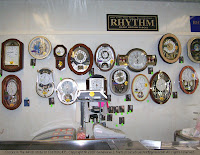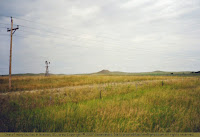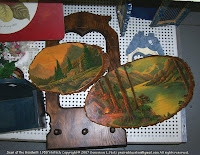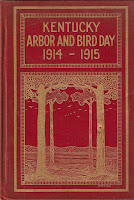Another Trip Down Memory Lane... Life in Kansas...
Our young rascal, Casper Cat, disappeared for a while today. About suppertime, we realized he was missing. When we called and Casper didn't appear, we decided to check the shed. Sure enough, when Dennis opened the shed door, there was Casper -- napping on the workbench. He awoke, stretched, and ambled out.
This reminded me of something I hadn't thought of for a while. When I was six and my family moved to the ranch at Rose (NE), there was an old cellar in the side yard. It looked like a small hill on the lawn. On one end, some steps led down to the cellar's door. The door and the cellar's floor were probably about 6 feet underground.
I was outside exploring the new surroundings and I decided to peek inside the cellar. I ventured down the steps and pulled the door open a few inches. To my surprise, an emaciated cat shot out like a bolt of lightning and began eating grass ravenously. Poor thing! He must have been locked in there for quite a while.
I also remember a bit about the cellar we had at the ranch south of Johnstown where we had lived before the move. As I recall, it was built into the side of a little hill, and the entry was at ground level on the outside. At any rate, the entry's roof slanted at an angle that reminded me of a playground slide. One day, I climbed it and slid down, and that night my mom picked out wood slivers from my legs and backside with a needle.
Those cellars were old, even when I was a little child. I don't think my mom used the one at Johnstown, and my dad tore out the one at Rose because it was in bad shape structurally. Wooden roofs of cellars tended to cave in. Concrete cellars were more durable.
Driving through the Ozarks, I've seen a few old cellars dug right into hillsides like caves. The front walls around the entry doors were made of native stone, mortared together.
I drew a little sketch of the cellars I remember from childhood and showed it to Isaac. He said, "Oh, like Uncle Dwight and Aunt Kathy's storm shelter." And he is absolutely correct about the similarity. Come to think of it, storm shelters are often called "storm cellars."
Not long after Dwight and Kathy and my parents moved to the ranch out west of Wichita, KS, a tornado passed by too close for comfort. Since they had no storm cellar, they got in the pickup truck, drove into the pit silo which sits deep in the ground between a couple of hills, and waited for the storm to pass over. Soon after that, Dwight built the storm shelter that Isaac was talking about. It's right there in the yard if they need it.

Dwight and Kathy's storm shelter is made of a huge old salvaged oilfield tank -- like maybe 2000 gallons in size(?) -- cut in half and set back into a small hill. (The other half of the tank was used for something else on the ranch that I don't recall right now.) On the part sticking out of the hillside, Dwight built a a door. The framing of the little stoop over the doorway is salvaged oilfield pipe.
Inside are a few lawn chairs so they can sit down. A dozen people could probably pack into the shelter if necessary, but it would be a little crowded.
The upside-down bucket on top is covering a vent that lets in a little fresh air. I assume the vent in the door has some mesh over the backside of it (or is completely closed off) because I remember Dwight saying he made it tight enough to keep out snakes.
With a few shelves and storage bins, Dwight's storm shelter would make a pretty good cellar, because it fits the criteria of being an underground room (though its round interior and steel walls are unique.) For conventional cellar construction, see "
An Old Time Cellar" that gives a general plan for constructing a wooden cellar. Mother Earth News also has an informative article about "
Root Cellars."
 Updated 3/22/07: I found a larger version of the photo and posted it this morning. When I wrote this last night, I was thinking that Dwight put the tank on its side and that the floor was rounded, but after some memory searching and looking at the photo closely, I believe the half-tank was turned upside down onto a concrete floor and the sides are the rounded part. I apologize for my confusion. It's been about ten years since I peeked inside it!
Updated 3/22/07: I found a larger version of the photo and posted it this morning. When I wrote this last night, I was thinking that Dwight put the tank on its side and that the floor was rounded, but after some memory searching and looking at the photo closely, I believe the half-tank was turned upside down onto a concrete floor and the sides are the rounded part. I apologize for my confusion. It's been about ten years since I peeked inside it!Technorati tags:
 In the Crofton store, an inventory of fancy clocks is displayed behind the cash register. Most of the clocks have chimes or play a song. There are a few minutes of much music and chiming in the store every hour and half hour.
In the Crofton store, an inventory of fancy clocks is displayed behind the cash register. Most of the clocks have chimes or play a song. There are a few minutes of much music and chiming in the store every hour and half hour.









 One more garter snake story -- also from my childhood in Nebraska. When I was about ten, my parents installed a new furnace. The furnace heated the house by running hot water through baseboard radiators and through coils under the floor.
One more garter snake story -- also from my childhood in Nebraska. When I was about ten, my parents installed a new furnace. The furnace heated the house by running hot water through baseboard radiators and through coils under the floor.




 You might enjoy reading this AP story:
You might enjoy reading this AP story:  The old expression that "Birds of a feather stick together" is still correct, but it's apparently not inclusive enough. These little birds operate more like the Arab proverb, "My brother and I against my cousin. My cousin and I against the enemy."
The old expression that "Birds of a feather stick together" is still correct, but it's apparently not inclusive enough. These little birds operate more like the Arab proverb, "My brother and I against my cousin. My cousin and I against the enemy."











